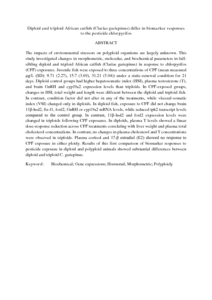Citation
Karami, Ali and Goh, Yong Meng and Jahromi, Mohammad Faseleh and James Lazorchak, Ali and Abdullah, Maha and Courtenay, Simon C.
(2016)
Diploid and triploid African catfish (Clarias gariepinus) differ in biomarker responses to the pesticide chlorpyrifos.
Science of The Total Environment, 557558 (July).
pp. 204-211.
ISSN 0048-9697; ESSN: 1879-1026
Abstract
The impacts of environmental stressors on polyploid organisms are largely unknown. This study investigated changes in morphometric, molecular, and biochemical parameters in full-sibling diploid and triploid African catfish (Clarias gariepinus) in response to chlorpyrifos (CPF) exposures. Juvenile fish were exposed to three concentrations of CPF (mean measured μg/L (SD): 9.71 (2.27), 15.7 (3.69), 31.21 (5.04)) under a static-renewal condition for 21 days. Diploid control groups had higher hepatosomatic index (HSI), plasma testosterone (T), and brain GnRH and cyp19a2 expression levels than triploids. In CPF-exposed groups, changes in HSI, total weight and length were different between the diploid and triploid fish. In contrast, condition factor did not alter in any of the treatments, while visceral-somatic index (VSI) changed only in diploids. In diploid fish, exposure to CPF did not change brain 11β-hsd2, ftz-f1, foxl2, GnRH or cyp19a2 mRNA levels, while reduced tph2 transcript levels compared to the control group. In contrast, 11β-hsd2 and foxl2 expression levels were changed in triploids following CPF exposures. In diploids, plasma T levels showed a linear dose-response reduction across CPF treatments correlating with liver weight and plasma total cholesterol concentrations. In contrast, no changes in plasma cholesterol and T concentrations were observed in triploids. Plasma cortisol and 17-β estradiol (E2) showed no response to CPF exposure in either ploidy. Results of this first comparison of biomarker responses to pesticide exposure in diploid and polyploid animals showed substantial differences between diploid and triploid C. gariepinus.
Download File
![[img]](http://psasir.upm.edu.my/55532/1.hassmallThumbnailVersion/Diploid%20and%20triploid%20African%20catfish%20%28Clarias%20gariepinus%29%20differ%20in%20biomarker%20responses%20.pdf)  Preview |
|
PDF (Abstract)
Diploid and triploid African catfish (Clarias gariepinus) differ in biomarker responses .pdf
Download (107kB)
| Preview
|
|
Additional Metadata
Actions (login required)
 |
View Item |

